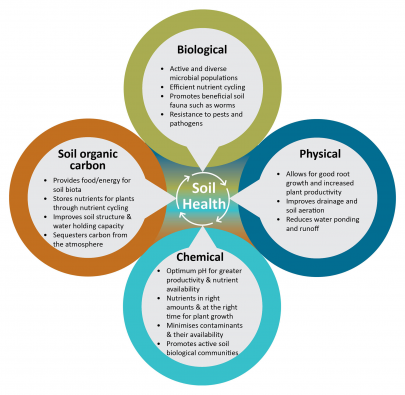Soil health factsheets

Figure 1. The components of a healthy soil and the benefits they provide. All four components interact to create a healthy soil.
The What is soil health? factsheet outlines components of a healthy soil and the benefits it provides. Soil properties vary depending on the complexity and location of the soil, land use, and trade-offs between the services they provide for humans, plants and animals. Figure 1 shows the four components that interact to create a healthy soil, i.e. biological, soil organic carbon, chemical, and physical components. Regardless of the land use, three basic soil health practices are generally recommended:
- Minimise disturbance and tillage of the soil
- Increase soil cover to minimise bare ground
- Increase plant diversity through diversifying rotations and/or species planted (which in turn increases soil fauna and microbe biodiversity)
This factsheet also shares information on the social perspectives of soil health and introduces soil health from a Te Ao Māori perspective.
The Soil Nutrients factsheet summarises information and principles of good soil nutrient management practices in agriculture and horticulture. The factsheet recommends best practices for nitrogen, phosphorus, and other macro-nutrients and micro-nutrients.
The Soil erosion and sediment control factsheet summarises and collates information on good erosion management and soil conservation practices that support key principles of soil erosion control. A healthy soil seeks to maintain or improve the different functions that soils perform. These functions can include retention of nutrients, climate regulation, and supporting biodiversity as well production of food and forage (which also benefit from maintaining the other soil functions).
Finally, the fourth factsheet Reducing compaction and pugging summarises information on good management practices for reducing or minimising soil compaction and pugging when grazing pasture. The concept of soil health is broad and holistic but encourages increasing the functionality of a soil to maintain a well-balanced ecosystem. A healthy and well-functioning soil will support agricultural production and help to minimise impacts to waterways.
- pdf Factsheet: What is soil health? pdf File, 737 KB
- pdf Factsheet: Soil nutrients pdf File, 456 KB
- pdf Factsheet: Soil erosion and sediment control pdf File, 742 KB
- pdf Factsheet: Reducing Compaction and pugging pdf File, 973 KB
